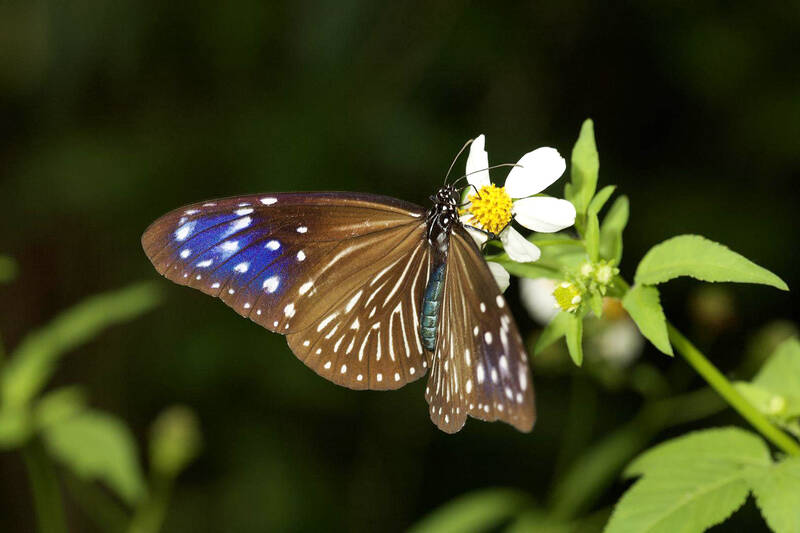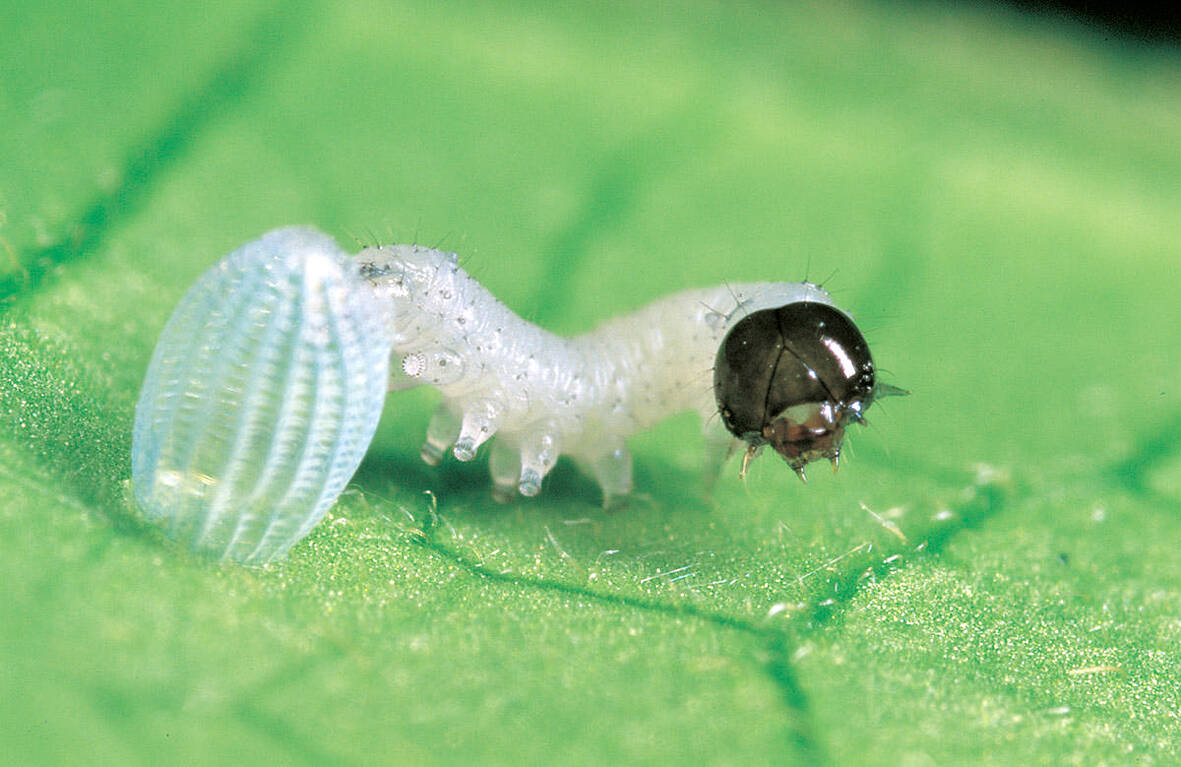Guided by the subdued, soothing and sometimes playful voice of singer Anpu (安浦), this stunning documentary uses ultra high speed (4k, 1,000fps) cameras to give the audience an extremely intimate view of the anatomy, life cycle and plight of the purple crow butterfly.
Once dubbed the Butterfly Kingdom, Taiwan boasts four subspecies of the creature named for the dazzling purple sheen its wings give off in the sunlight. There used to be five subspecies, but one has not been seen since the 1960s. Their 400km-long winter migration is one of the two largest in the world, the other being the flight of the monarchs from the US to Mexico.
Born in the north, the purple crow butterflies flock to valleys in the south in the tens of thousands when the weather gets cold, making for a spectacular sight called the “butterfly highway.” But their numbers have been sharply decreasing due to climate change, habitat destruction and the building of highways that block their travel routes.

Photo courtesy of Activator Marketing Corp
They’re not endangered yet, but dozens of “butterfly valleys” have disappeared in recent years, indicating an imbalance in the natural ecology. What will happen if they completely disappear one day?
Conservationist Chan Chia-lung (詹家龍) spent five years shooting absolutely gorgeous, close-up scenes of the butterflies that often show the minute details of its tiny wings filling up the entire theater screen. It’s a sumptuous feast for the eyes, as we not only rarely get to observe the life processes of these butterflies (who knew they had metallic, reflective chrysalises?), but their movements are often too rapid to observe with the naked eye — or even regular video cameras.
The sound of their wings beating is also presented, and since that’s the only noise they make, the cheery, whimsical original soundtrack by the renowned Tu Duu-chih (杜篤之) helps drive the story forward and set the pace.

Photo courtesy of Activator Marketing Corp
Chan also shows in detail the many gruesome ways they may meet their end, from being eaten from the inside out by parasitic wasp larvae, to collapsing out of exhaustion and being devoured by other insects. In one scene, the butterflies are shown struggling to cross a highway, many meeting their fate on the tires of a truck. When butterflies were way more abundant, families bolstered their income by hunting them, turning them into specimens and even using their wings to create “butterfly paintings” that were sold abroad.
Anpu speaks directly to her subject in the second person — from the moment it eats its way out of the egg to the trials and tribulations it will encounter. It’s a curious device that works just fine, but at times gets a little too cutesy as though the butterflies (and the audience) are children.
The narration anthropomorphizes the butterflies as the charming, magical heroes of this tale, using human emotions, sensory experiences and complex concepts to describe their behaviors. But some of the commentary is a bit far-fetched, assigning the purple crow butterflies attributes and thinking that elevates them above other insect species.

Photo courtesy of Activator Marketing Corp
Anyhow, this treatment does make the butterflies more relatable and appealing to a wider audience, and also makes it more fun to watch than a serious nature doc. The goal seems to be to make people care about them and strive to protect them. The parts dealing with death are handled quite well, the music doesn’t suddenly get sad and it’s by no means painted as a tragedy. Don’t be upset, Anpu says, this is just part of the cycle of life. Your body will serve to nourish other insects before it returns to dust.
The film makes use of quite a bit of aerial footage from the Chi Po-lin Foundation (齊柏林) to show the butterflies’ habitat and migration journey. There’s one strange error on the part showing the journey south, when a scene of Taipei suddenly appears after they have reached Kaohsiung.
It’s wonderful to be able to see the minute processes of the butterfly’s life cycle, but that takes up the bulk of the 82-minute running time. Chan doesn’t want to get too preachy, preferring to let the story speak for itself. But the film could have expounded a bit more on the human impact on these delightful creatures and the implications of their population decrease, and how they can be protected.
There’s also a segment describing the butterfly-related legends of ancient China and Greece, but what about their relationship to the indigenous Rukai and Paiwan people, in whose traditional territories they spend the winter?
Sponsored by Yushan Bank (玉山銀行), this crowdfunded film premieres just three months after the hynobius salamander documentary Good Morni MIT (山椒魚來了), which also introduces through a celebrity narrator (Wubai, 伍佰) the life of a tiny, often overlooked creature that’s also seeing its habitat disappear. Hopefully this becomes a trend, as there’s so much of Taiwan’s rich biodiversity that most urban folk are unaware of. One might question the need to go to a theater to watch a nature documentary, but seeing these amazing shots on the big screen is worth the while.

June 9 to June 15 A photo of two men riding trendy high-wheel Penny-Farthing bicycles past a Qing Dynasty gate aptly captures the essence of Taipei in 1897 — a newly colonized city on the cusp of great change. The Japanese began making significant modifications to the cityscape in 1899, tearing down Qing-era structures, widening boulevards and installing Western-style infrastructure and buildings. The photographer, Minosuke Imamura, only spent a year in Taiwan as a cartographer for the governor-general’s office, but he left behind a treasure trove of 130 images showing life at the onset of Japanese rule, spanning July 1897 to

In an interview posted online by United Daily News (UDN) on May 26, current Chinese Nationalist Party (KMT) Chairman Eric Chu (朱立倫) was asked about Taichung Mayor Lu Shiow-yen (盧秀燕) replacing him as party chair. Though not yet officially running, by the customs of Taiwan politics, Lu has been signalling she is both running for party chair and to be the party’s 2028 presidential candidate. She told an international media outlet that she was considering a run. She also gave a speech in Keelung on national priorities and foreign affairs. For details, see the May 23 edition of this column,

The Taiwan People’s Party (TPP) on May 18 held a rally in Taichung to mark the anniversary of President William Lai’s (賴清德) inauguration on May 20. The title of the rally could be loosely translated to “May 18 recall fraudulent goods” (518退貨ㄌㄨㄚˋ!). Unlike in English, where the terms are the same, “recall” (退貨) in this context refers to product recalls due to damaged, defective or fraudulent merchandise, not the political recalls (罷免) currently dominating the headlines. I attended the rally to determine if the impression was correct that the TPP under party Chairman Huang Kuo-Chang (黃國昌) had little of a

At Computex 2025, Nvidia CEO Jensen Huang (黃仁勳) urged the government to subsidize AI. “All schools in Taiwan must integrate AI into their curricula,” he declared. A few months earlier, he said, “If I were a student today, I’d immediately start using tools like ChatGPT, Gemini Pro and Grok to learn, write and accelerate my thinking.” Huang sees the AI-bullet train leaving the station. And as one of its drivers, he’s worried about youth not getting on board — bad for their careers, and bad for his workforce. As a semiconductor supply-chain powerhouse and AI hub wannabe, Taiwan is seeing